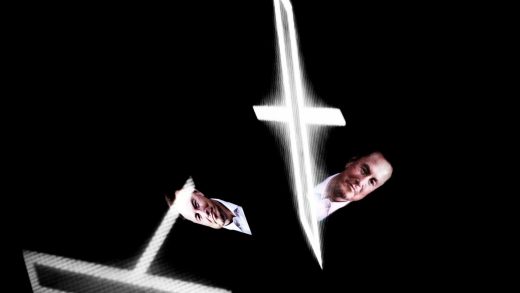:format(webp)/https://www.thestar.com/content/dam/thestar/entertainment/2022/08/01/summerworks-is-back-and-wants-to-reimagine-the-possibilities-of-performance/future_perfect.jpg)
SummerWorks is set to descend upon every nook and cranny of the city, an ambitious, post-pandemic festival of cutting-edge contemporary performances.
The return of Toronto’s annual festival will see its geographic scope extend far beyond its traditional Queen Street West/Theatre Centre mainstage. SummerWorks runs from Aug. 4 to 14.
The programming, from large scale to intimate, is designed to be as accessible as possible in live, virtual and hybrid presentations. There’s an emphasis on reimagining the possibilities of performance and the artist/audience connection, and on leveraging the festival to animate public spaces and investigate how we perceive and relate to the city.
Laura Nanni is overseeing her seventh and final festival as SummerWorks’ artistic and managing director. “The festival’s physical choreography mimics its conceptual nature. How do we see things from difference perspectives? What are some of the questions artists are asking?” she said.
The Star’s Aisling Murphy and Michael Crabb offer a guide to a citywide festival that has multiple access points and a dizzyingly varied roster of events, many of them free, family-friendly and sure to appeal to a diverse audience.
A roaming feast
If your idea of a performance is something that happens in a darkened space with a strict demarcation between artists and audience, SummerWorks wants you to think again.
For 11 days this August, the festival’s multi/cross/interdisciplinary and sometimes participatory programming will take you from Cherry Beach in the east to Sunnyside in the west — with a stop on the Toronto Islands — and north to the Junction as you immerse yourself in events indoors and out that probe and reinvent the very nature of performance.
Apart from the fully developed new works in its Presentation series, SummerWorks has several distinct streams that intermingle in terms of artistic objectives and ideas.
As the name suggests, SummerWorks’ Lab stream is all about exploration, experimentation and the incubation of new work in existing and yet-to-be formulated disciplines. It’s about testing boundaries and thinking big, and an eye-opener for those curious about how art is made.
With professional and emerging artists in mind, SummerWorks’ Exchange stream includes workshops, discussions, mentorship and pitching opportunities. Within the scheduled events, choreographer Aria Evans will lead a participatory session Aug. 9 entitled Building Consent, in which she will explore what consent means in portrayals of intimacy and in interdisciplinary collaboration. In keeping with the festival’s desire to open its offerings to a potentially global audience, another Exchange event, Curating the Digital, will be offered exclusively online beginning Aug. 9.
A major and expanded component of the festival this year is a community engagement stream called Public Works, which aims to bring artists and audiences together to experience the city in new ways. For example, from Aug. 5 to 7 you can join author, artist, photographer and musician Shari Kasman on a guided early evening tour of Toronto’s Bloordale district. The tour promises “an innovative blend of fact and fiction … to highlight the weird, wonderful and whimsical.” It’s free, but you’ll need to register and the exact starting point will be emailed to you the day before the event.
For those who’ve scratched their heads over some of the idiotic city bylaws inflicted upon us, another free Public Works event will bring a smile to your face.
Future Perfect: New By-laws for Civic Spaces is the brainchild of Canadian artists Mia & Eric, and the U.K.’s Action Hero. It focuses on bylaws that seek to regulate our behaviour in civic spaces, in this case Toronto’s parks. The bylaws are cut up word by word and meticulously rearranged into a new set of rules “for a transitioning world.” In enlarged form, these will appear on walls and billboards throughout the city.
Let’s hope the best new bylaws are adopted.
A barrier-free festival
This year’s SummerWorks performances, for the most part, centre on concepts of accessibility and care.
For Laura Nanni, artistic and managing director of the festival, these are not just choices made to tick boxes. They’re a vital through-line of the festival’s identity.
“We’re always trying to remove barriers,” said Nanni, adding that a 2019 audit determined the festival’s core values were care and collaboration, creative risk and curiosity.
“We have shows that have deaf artists involved; we’ve been able to prioritize putting extra resources toward those projects. We’re able to have ASL interpreters not only at the performances but in the rehearsals as well. It’s not just tacked on. It’s thought about from all stages of development in the work.”
That thoughtfulness shines through in the programming. In “Higher Hair,” performers and spiritual guides Hima Batavia and Nikola Steer (who also goes by Coco Framboise) invite audiences into an intimate space wherein, with consent, they play with the hair of audience members. It’s a ritualistic experience, with gentleness and tenderness at its centre — a performance unlike any other.
The SummerWorks Lab offering “Does That Make Me Crazy?” highlights care and accessibility less literally, weaving those themes into its playwriting and direction. The performance tells a story of a mixed-race family over three decades, highlighting themes of Black liberation and mental health. Using live performers, puppetry and music, the project aims to explore an otherwise underexplored cross-section of identity and personal history.
Many of this year’s SummerWorks endeavours also feature aspects of digital technology, making them hybrid experiences for both artists and audiences.
“We know there’s a deep desire for people to return to liveness,” said Nanni. “But there will always be a place for technology and hybrid performance. It’s part of the language of the work we do and it lets us reach a wider audience.
“We’re interested in providing a platform for different perspectives and digital technology is such a good space for that. It’s a first step in overcoming physical barriers.”
This year’s Exchange series includes a workshop in which participants learn the basics of creating an augmented reality installation. “AR(umination),” as it’s called, combines reflections on the land of Toronto with digital technologies. The workshop gives participants the tools to create augmented reality landscapes: virtual experiences that combine real life and digital commentary.
“Collider,” a Lab offering, is another hybrid endeavour, using virtual reality to recreate the feeling of being in a rehearsal room. Artists are represented by avatars; they interact with virtual objects; they react to 3D soundscapes. Participants versed in VR will be able to join through their own equipment.
“The pandemic has perhaps accelerated our experimentation with hybrid performance,” said Nanni. “We’re reaching these audiences in really inventive ways.”
JOIN THE CONVERSATION
:format(webp)/https://www.thestar.com/content/dam/thestar/entertainment/2022/08/01/summerworks-is-back-and-wants-to-reimagine-the-possibilities-of-performance/laura_nanni_2.jpg)
:format(webp)/https://www.thestar.com/content/dam/thestar/entertainment/2022/08/01/summerworks-is-back-and-wants-to-reimagine-the-possibilities-of-performance/collider_2.jpg)



